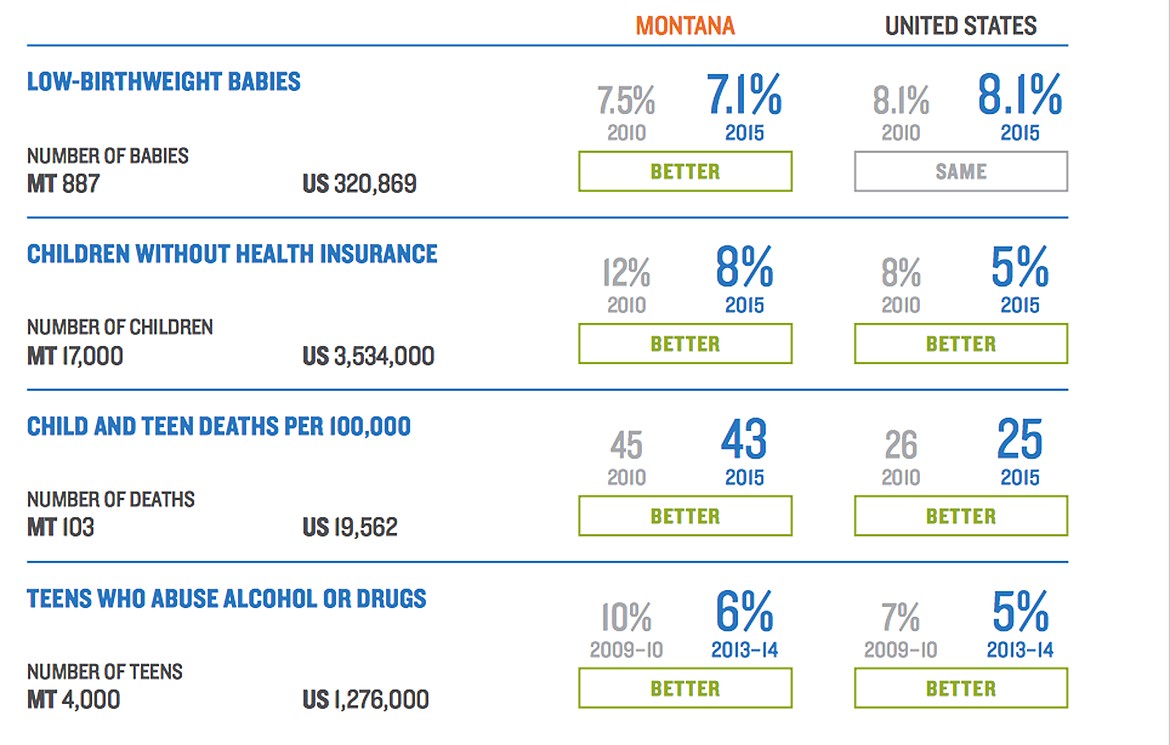Montana tops nation in child, teen deaths
Montana’s children and teens are dying at a higher rate than anywhere else in the nation, according to the 2017 National Kids Count Data Book released Tuesday by the Annie E. Casey Foundation. It’s the second time since 2010 the state has placed last for its high number of young deaths.
Jennifer Calder with Montana Kids Count said that ranking is “unfortunately, not much of a surprise.
“Montana has been on the bottom consistently,” Calder said. “But this marks a particularly bad year.”
The Annie E. Casey Foundation annual Kids Count report takes a look at patterns in health, education, community and economic well-being among the nation’s kids. The report, released June 13, relies on 2015 data pulled from sources like the U.S. Census Bureau.
While Montana ranks in the top 20 in the categories of economics, education and family situations for children, it ranks in the bottom four in children’s health.
“There have been struggles around the health domain for a while,” Calder said.
For example, she said one in five Montana children still live in poverty.
“We need to be engaged and concerned — a child born into poverty is more likely to be an adult living in poverty,” she said. “We look to the data like that to understand what still needs to be done.”
SHE SAID this year’s report also points to the need to better understand how to avoid preventable deaths.
In 2015, there were 103 youth deaths in Montana — up from 70 deaths the year before. Calder said of those deaths, 76 were preventable.
Vehicle fatalities and suicides drove the increase. Calder said 29 young Montanans died in car accidents and another 18 died by suicide.
She said while statistics on youth suicide are grim, there’s been more effort shaped around the issue in recent years and even months.
This summer, Gov. Steve Bullock signed into law legislation that will provide $1 million toward suicide prevention over the next two years.
Rep. Jonathan Windy Boy, D-Box Elder, sponsored the law, which will create programs to reduce suicide among Native American youth as well as veterans. The dollars will also support school-based suicide prevention programs.
Weeks after the bill became law, Montana broadcasters unveiled a series of ads for radio and television as part of a campaign to help people recognize and respond to signs that someone might be considering self-harm.
“There’s more public awareness, more conversations out there trying to reduce the stigma of talking about these health issues,” Calder said.
THE 2017 report also points to places of improvement in Montana kids’ health, according to Calder.
Matching national trends, the 2017 Kids Count report showed fewer Montana kids are drinking or doing drugs.
Montana also saw a 29 percent drop in the teen birth rate and a 25 percent decline in children living in families where the head of household didn’t have a high school diploma between 2010 and 2015, when the most recent information was collected.
There are also fewer children living without health insurance. Around 8 percent, or 17,000, Montana kids don’t have insurance, according to the report. That’s down from a 14 percent uninsured rate in 2010. Calder said that’s largely due to the combination of provisions of the Affordable Care Act, expansions to Medicaid, the Children’s Health Insurance Program and the Healthy Montana Kids public health insurance.
While the state’s numbers are improving, Calder said there’s still some ground to make up as the national average of kids without health coverage hovers at a historic low of 5 percent.
Montana Kids Count Director Thale Dillon said Montana can continue to improve if policymakers rely on data to pinpoint kids’ unmet needs.
“It is important that we do not back away from targeted investments that are proven to make Montana’s children healthier and more likely to grow into productive citizens,” Dillon said.
He said those investments are important for the future of individuals and the state.
For more information and to read the full report, visit http://www.aecf.org.
Reporter Katheryn Houghton may be reached at 758-4436 or by email at khoughton@dailyinterlake.com.


